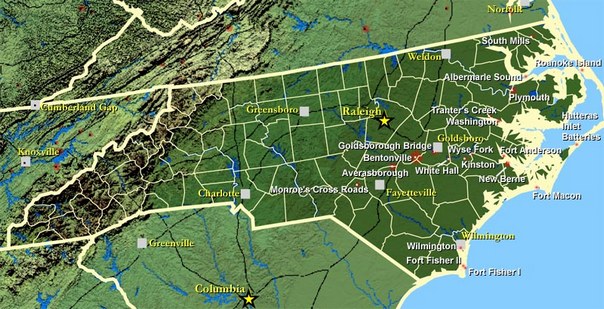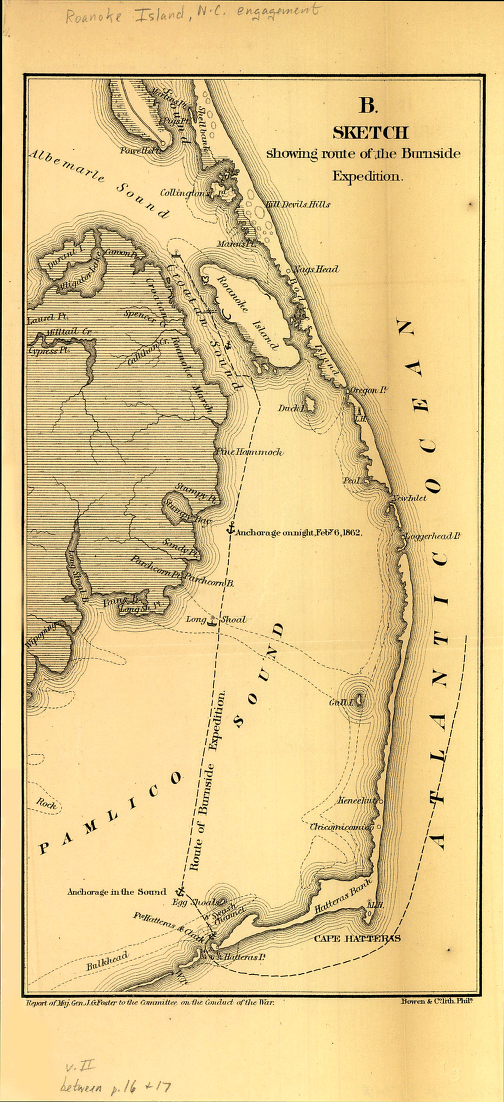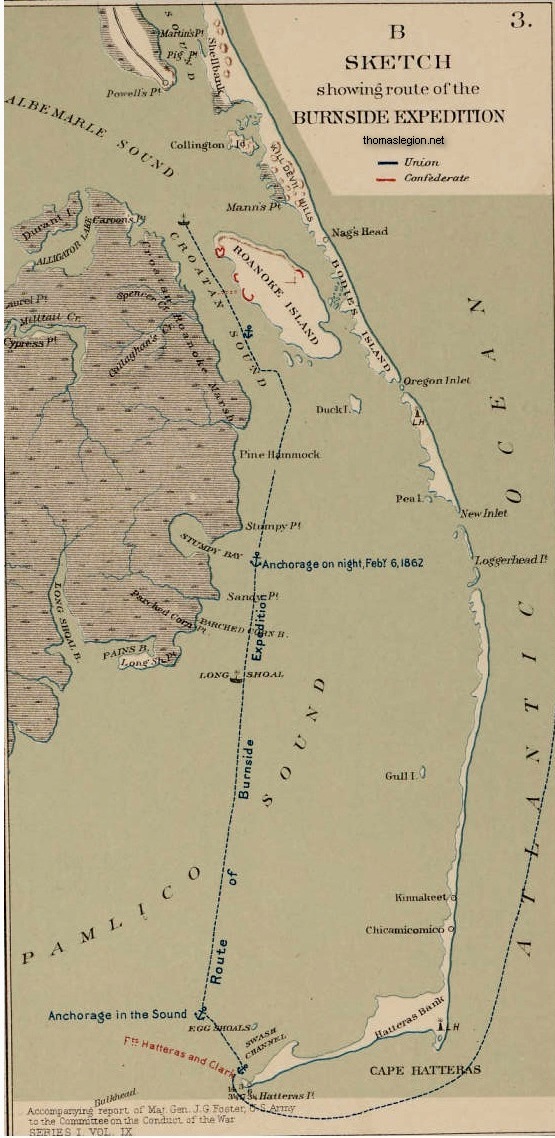|
North
Carolina Civil War History
Burnside's North Carolina Expedition
A North Carolina Coast Civil War History
Introduction
Burnside's North Carolina Expedition, commonly called the Burnside
Expedition, was a series of engagements fought along the North Carolina Coast between February and June 1862 of the American
Civil War (1861-1865). This expedition was part of Winfield Scott's Anaconda Plan, which aimed at closing blockade-running
ports inside the Outer Banks of Old Carolina. The amphibious operation was carried out primarily by New England troops
under Brig. Gen. Ambrose E. Burnside and assisted by the North Atlantic Blockading Squadron under Captain Louis M. Goldsborough.
Upon conclusion of the expedition, the Federals would next push inland during a series of punishing operations, raids,
campaigns, and expeditions.
| North Carolina Civil War Battles |

|
| North Carolina Civil War Battlefields Map |
Setting the Stage
"Confronted by the massive Union force, the small Confederate contingent
resorted to antiquated smooth-bore cannon, mounted on the front wheels of ordinary farm wagons, drawn by mules with plow harnesses;
said weaponry was opposed by the latest columbiads and Parrot guns of Goldsborough's fleet. The majority of the Rebel
soldiers, furthermore, were armed with squirrel rifles or fowling-pieces with carving knives in place of bayonets."
On February 7, 1862, a hundred-vessel Union flotilla steamed down Croatan
Sound to land a massive amphibious force on Roanoke Island. Union General Ambrose E. Burnside led 15,000 Federal troops
while Flag Officer Louis Goldsborough commanded the naval contingent. By
capturing Roanoke Island, the combined Union army and naval forces would have a base and location to launch attacks against
the Confederate army located in North Carolina.
| Burnside Expedition Route Map |

|
| Burnside's North Carolina Expedition |
| North Carolina and the Civil War |

|
| Burnside Expedition Map |
(Above) Map of Burnside Expedition. Sketch showing initial route taken
by Burnside as the Union fleet progressed the Atlantic Ocean before sailing into the Pamlico and Croatan sounds. (Right)
Burnside Expedition. Color enhanced sketch showing route of the Burnside Expedition during January
and February 1862. The expedition, which began in February 1862, would conclude in early June of 1862 with the Federal
victory at Tranter's Creek. Red designates Confederate affiliation while blue designates Union. Official Records of the War
of the Rebellion.
Opposing the Federals were approximately
3,000 Confederate soldiers under the command of Colonel Henry M. Shaw. North Carolina officials and generals, however,
had petitioned the "Confederate high command" for prompt reinforcements against an imminent Union attack. But, with
a series of engagements currently in progress in Virginia, the Confederacy could not afford to send any additional
troops. Hence, the meager Confederate force would simply have to make the best of the situation and defend the critical
North Carolina coast and outer banks. Meanwhile, Flag Officer William F. Lynch opposed the massive Union fleet with
only seven gunboats and a three-gun battery. In addition, three Confederate forts were located on the northwestern portion
of the twelve-mile-long island; however, because of the location of the forts and the direction of the combined Union assault,
the three forts were ineffective. (The Confederate forts were out of range because the Union forces had flanked
them.)
| Map of North Carolina Civil War Battles |

|
| North Carolina Civil War Battlefields |
The Amphibious Assault
Lynch, seizing the initiative, boldly led his ‘fledgling fleet’
against the advancing massive Union fleet, but Goldsborough defeated them quickly and subsequently landed the Union troops
at Ashby’s Harbor.
By midnight, the Federals occupied the beach, and at 8 a.m. that morning,
they launched an aggressive assault against the Confederates, who were retreating north. Approximately six miles (halfway
point of Roanoke Island) northward, 1,500 Confederates and a battery greeted Burnside’s men. Burnside, however,
outflanked the enemy, and the Confederates retreated once again, only to surrender to Burnside’s forces at the northern
tip of Roanoke Island.*
The Confederate Resistance: An Inland Defense
Burnside next turned his attention
and efforts on New Bern (spelled New Berne at the time). Confederate General Lawrence O. Branch, commanding an inadequate
number of troops in that area, decided to defend the city in fortifications located approximately six miles south and adjacent
the Neuse River.
Burnside, however, landed his men twelve miles downriver on March 13 and
began marching toward New Bern. Determined to smash the Union invaders, Branch had redeployed his Rebel force closer
to the city, and his men now braced for the attack, which began the next morning.
Although the Confederates held off the advancing Union troops for several
hours, eventually the Confederate center collapsed, and Branch’s soldiers retreated. Some Rebels, after they crossed
the Trent River into New Bern, and as Federal gunboats shelled them, burned the bridge behind them.
Realizing his position was untenable, Branch withdrew his men by rail to
Kinston. Burnside’s powerful force occupied New Bern the next day, and remained in Federal hands until the end
of the war. (Gen. George E. Pickett, of Pickett's Charge fame, made failed attempt to recapture it in 1864.)
Burnside now advanced and captured both Beaufort and Fort Macon (a vital location), and, for his invaluable successes, was
promoted on March 18.
*Roanoke Island Results: The loss of the Confederates was 23 killed and
62 wounded; among the killed were Captain O. Jennings Wise, and Lieutenants Seldon and Munroe. The Federal loss was, killed,
37, wounded, 214. Colonel Shaw surrendered about 2,000 men, including his sick. The difference between this force and his
reported effectives comes from the fact, that, after the main battle, the Second North Carolina Battalion (eight companies) and Major Fry with four companies of the Forty-sixth
Virginia arrived on the Island and were included in the surrender.
**D. H. Hill, Jr., son of Confederate Lieutenant General Daniel Harvey Hill,
Sr., was the author of Confederate Military History Of North Carolina: North Carolina
In The Civil War, 1861-1865. North Carolina native Daniel Harvey Hill, Sr., commonly referred to as
D. H. Hill , was one of only two lieutenant generals from the Tar Heel State. (Lieutenant general was the second
highest rank in the Confederate Army.) Hill, Sr., was also brother-in-law to "Stonewall" Jackson.
Recommended Reading: Ironclads and Columbiads:
The Coast (The Civil War in North Carolina) (456 pages). Description: Ironclads and Columbiads covers
some of the most important battles and campaigns in the state. In January 1862, Union forces began in earnest to occupy crucial
points on the North Carolina coast. Within six months, Union army and naval forces effectively controlled coastal North Carolina
from the Virginia line south to present-day Morehead City. Continued below...
Union setbacks in Virginia, however, led to the withdrawal of many federal soldiers from North Carolina,
leaving only enough Union troops to hold a few coastal strongholds—the vital ports and railroad junctions. The South
during the Civil War, moreover, hotly contested the North’s ability to maintain its grip on these key coastal strongholds.
Burnside's North Carolina Expedition [February-June 1862]
Related Studies:
North Carolina Coast and the American Civil
War
Recommended Reading: Storm over Carolina:
The Confederate Navy's Struggle for Eastern North Carolina. Description: The struggle for control of the eastern
waters of North Carolina during the War Between the States was a bitter, painful, and sometimes humiliating one for the Confederate
navy. No better example exists of the classic adage, "Too little, too late." Burdened by the lack of adequate warships, construction
facilities, and even ammunition, the South's naval arm fought bravely and even recklessly to stem the tide of the Federal
invasion of North Carolina from the raging Atlantic. Storm Over Carolina is the account of the Southern navy's struggle in
North Carolina waters and it is a saga of crushing defeats interspersed with moments of brilliant and even spectacular victories.
It is also the story of dogged Southern determination and incredible perseverance in the face of overwhelming odds. Continued
below...
For most of the Civil War, the navigable portions of the Roanoke, Tar, Neuse,
Chowan, and Pasquotank rivers were occupied by Federal forces. The Albemarle and Pamlico sounds, as well as most of the coastal
towns and counties, were also under Union control. With the building of the river ironclads, the Confederate navy at last
could strike a telling blow against the invaders, but they were slowly overtaken by events elsewhere. With the war grinding
to a close, the last Confederate vessel in North Carolina waters was destroyed. William T. Sherman was approaching from the
south, Wilmington was lost, and the Confederacy reeled as if from a mortal blow. For the Confederate navy, and even more so
for the besieged citizens of eastern North Carolina, these were stormy days indeed. Storm Over Carolina describes their story,
their struggle, their history.
Recommended Reading: Confederate Military History Of North Carolina:
North Carolina In The Civil War, 1861-1865. Description: The author, Prof. D. H. Hill, Jr., was the son of Lieutenant
General Daniel Harvey Hill (North Carolina produced only two lieutenant generals and it was the second highest rank in the
army) and his mother was General “Stonewall” Jackson’s wife's sister. In Confederate Military History Of
North Carolina, Hill discusses North Carolina’s massive task of preparing and mobilizing for the conflict; the many
regiments and battalions recruited from the Old North State; as well as the state's numerous contributions during the war.
Continued below...
During Hill's Tar Heel State study, the reader begins with interesting and
thought-provoking statistical data regarding the 125,000 "Old North State" soldiers that fought during the course of the war
and the 40,000 that perished. Hill advances with the Tar Heels to the first battle at Bethel, through numerous bloody campaigns
and battles--including North Carolina’s contributions at the "High Watermark" at Gettysburg--and concludes with Lee's
surrender at Appomattox.
Recommended Reading: The Civil War in North
Carolina. Description: Numerous battles and skirmishes were fought in North Carolina during the Civil
War, and the campaigns and battles themselves were crucial in the grand strategy of the conflict and involved some of the
most famous generals of the war. John Barrett presents the complete story of military engagements across the state, including
the classical pitched battle of Bentonville--involving Generals Johnston and Sherman--the siege of Fort Fisher, the amphibious
campaigns on the coast, and cavalry sweeps such as General Stoneman's Raid.
Recommended Reading: The Flags of Civil
War North Carolina. Description: Compiled and written by educator and Civil War expert Glenn Dedmondt,
The Flags Of Civil War North Carolina is a very straightforward reference presenting photographs, color illustrations, descriptions
and history of the titular flags that flew over North Carolina when it seceded from the Union. Each page or two-page spread
features the different flags of the various North Carolina regiments. A meticulously detailed resource offering very specific
information for history and civil war buffs, The Flags Of Civil War North Carolina is a welcome contribution to the growing
library of Civil War Studies and could well serve as a template for similar volumes for the other Confederate as well as Union
states. Great photos and illustrations! Continued below...
Flags stir powerful emotions, and few objects evoke such a sense of duty
and love for the homeland. In April 1861, the first flag of a new republic flew over North Carolina. The state had just seceded
from the union, and its citizens would soon have to fight for their homes, their families, and their way of life. Each flag
is meticulously detailed and scaled to perfection. The Flags of Civil War North Carolina is the history of this short-lived
republic (which later joined the Confederacy), told through the banners that flew over its government, cavalry, and navy.
From the hand-painted flag of the Guilford Greys to the flag of the Buncombe Riflemen--made from the dresses of the ladies
of Asheville--this collection is an exceptional tribute to the valiant men who bore these banners and to their ill-fated crusade
for independence. About the Author: Glenn Dedmondt, a lifelong resident of the Carolinas and member of the Sons of Confederate
Veterans, shares his passion for the past as a teacher of South Carolina history. Dedmondt has also been published in Confederate
Veteran magazine.
Recommended Reading: The Civil War in the
Carolinas (Hardcover). Description: Dan Morrill relates the experience of two quite different states
bound together in the defense of the Confederacy, using letters, diaries, memoirs, and reports. He shows how the innovative
operations of the Union army and navy along the coast and in the bays and rivers of the Carolinas affected the general course
of the war as well as the daily lives of all Carolinians. In the latter part of the war, he describes how Sherman's operation
cut out the heart of the last stronghold of the South. Continued below...
The author offers fascinating sketches of major and minor personalities, including the new president and
state governors, Generals Lee, Beauregard, Pickett, Sherman, D.H. Hill, and Joseph E. Johnston. Rebels and abolitionists,
pacifists and unionists, slaves and freed men and women, all influential, all placed in their context with clear-eyed precision.
If he were wielding a needle instead of a pen, his tapestry would offer us a complete picture of a people at war.
|

